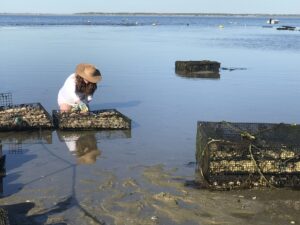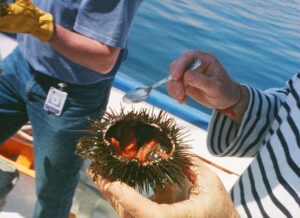PROVINCETOWN — Michael and Kalliope Chute, who have operated the Mermaid Menu oyster farm on the flats in Provincetown Harbor for several years, hope to expand their business this summer to include green sea urchins.

The echinoderm — the sea urchin belongs to a phylum that also includes starfish and sand dollars — is native to the area, but its numbers have been dramatically diminished because of overfishing in the 1990s.
Green sea urchins are prized for the orange lobes of flesh arrayed in a star shape inside their prickly exteriors. This edible part of the urchin — known to denizens of sushi bars as uni and also referred to as roe — is actually the animal’s reproductive tissue. It’s considered a delicacy in Japan and Europe.
Sea urchins are becoming more popular in the Northeast, and Maine, where the water is cold, has been the frontrunner in revitalizing the industry in New England, according to the Maine Dept. of Marine Resources website.
The Chutes are in the process of securing a special permit from the state Div. of Marine Fisheries (DMF) for the commercial farming of green sea urchins. Michael said it would be the first special permit for green sea urchins in the state.
Kalliope remembers seeing green sea urchins picked up by dredges along the sea floor in local waters before they were overfished.
This time, the urchins won’t be free-ranging. They will be in mesh bags like those used for oysters. “We’re excited to bring them back in a controlled environment,” she said.
The DMF advised the Chutes to work with the shellfish constable and shellfish advisory committee. The agency also recommended a public hearing before the select board, which is scheduled for June 9. If the board has no objection to the Chutes’ project, the DMF will then review it.
If a permit is granted, the Chutes will begin the season with 3,000 juvenile green sea urchins provided by the University of Maine’s Center for Cooperative Aquaculture Research, which runs the only sea urchin hatchery in the U.S. and offers seed as well as guidance for new sea urchin farmers.
The Chutes say the value of the green sea urchin is in reducing the accumulation of seaweed and algae on equipment in their oyster farm as well as in providing some income, if all goes well.

Algae and seaweed are the primary foods of green sea urchins. Both are the bane of oyster farmers, clogging the holes in the mesh bags where young oysters are kept and getting tangled on the cages of larger oysters, hindering the flow of water that is essential for the oysters’ growth. The problem is called biofouling.
“The more water the oysters are given and the more nutrients they have to eat, the faster they will grow,” Michael said. “We’re always out there working against it to keep the water flowing through the cages for the oysters.”
The Chutes plan to place the sea urchins in mesh shellfish bags called cages to make it possible to move them around the farm as needed to clean up the algae. Some of sea urchins will go in bags with the oysters and others in bags by themselves. They also plan to vary the depth of the cages, putting some sea urchins in floating cages and others on the sea floor to gauge what conditions the echinoderms favor.
At the same time that the Chutes are seeking the town’s permission to grow sea urchins, they are pursuing a state license that would allow them to sell their harvest. “The nice thing about green sea urchins is it’s a winter market, from Nov. 15 to April 15,” Michael said. “It would be an economic multiplier for us because currently that’s when the oyster market drops off.”
The Chutes sell all of their oysters to the Canteen for its restaurant and catering operations. They envision a similar “local boutique market” for the sea urchins.
Steve Eddy, director of the University of Maine’s Center for Cooperative Aquaculture Research, provided the Chutes with a recommendation letter. It confirms that the green sea urchins are native to Cape Cod and would not be considered a non-native species being introduced on the flats — one concern the board or other growers and fishermen might have.
“Incorporating sea urchins into a caged confinement system will not produce a local population boom of wild urchins, and even if they escaped or allowed free-range, they would pose no threat to the local shellfish populations,” Eddy said in his letter.
The animals are slow-growing and won’t reach market size, 2.5 inches in diameter, for three to five years. While green sea urchins are omnivores, they don’t target shellfish, worms, finfish, crabs, or other commercially important fisheries, Eddy wrote.
Shellfish Constable Stephen Wisbauer said the Chutes have taken “the correct path,” beginning with outlining their plan for the town’s shellfish advisory committee. After a discussion there, “they walked out with a recommendation for approval” to give to the select board, Wisbauer said. “With this recommendation, I don’t see any problem.”
